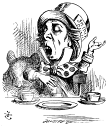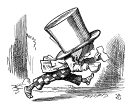Search us!
Search The Word Detective and our family of websites:
This is the easiest way to find a column on a particular word or phrase.
To search for a specific phrase, put it between quotation marks. (note: JavaScript must be turned on in your browser to view results.)
Ask a Question! Puzzled by Posh?
Confounded by Cattycorner?
Baffled by Balderdash?
Flummoxed by Flabbergast?
Perplexed by Pandemonium?
Nonplussed by... Nonplussed?
Annoyed by Alliteration?

Don't be shy!
Send in your question!
Columns from 1995 to 2006 are slowly being added to the above archives. For the moment, they can best be found by using the Search box at the top of this column.
 If you would like to be notified when each monthly update is posted here, sign up for our free email notification list.
If you would like to be notified when each monthly update is posted here, sign up for our free email notification list.
Trivia
All contents herein (except the illustrations, which are in the public domain) are Copyright © 1995-2020 Evan Morris & Kathy Wollard. Reproduction without written permission is prohibited, with the exception that teachers in public schools may duplicate and distribute the material here for classroom use.
Any typos found are yours to keep.
And remember, kids,
Semper Ubi Sub Ubi
|
 Semper Ubi Sub Ubi readme:
OK, slightly late this month. No reason to panic.
Whoa. Christmas is in a week? How did that happen? Where did we put the decorations from last year? Oh right. They’re still on the dining room sideboard. How convenient. Thank heavens we left the tree up in the living room. Just vacuum off the cat hair, be careful with open flames, and we’re good to go.
Time flies, doesn’t it? It seems like only a month ago that we took the lights off the tree in the front yard, but that was actually way back in May. Now it’s time for me to climb the ladder again, fall on my head again, and lie there like a stunned moose while the neighbors drive by and gawk. He looks dead, Ruthie. Should we stop? How late is Target open?
Before I forget, and lest you forget, let me mention for the umpteenth time this year that subscriptions to TWD-by-Email make lovely gifts, can be had for a paltry $15 per year, and, best of all, can be obtained in the comfort of wherever you’re sitting right now. If you’re worried that the tie you bought for your crazy uncle won’t be sufficiently distracting to prevent his snarky remarks about the stuffing, we can fix that. Just hit him with a Lifetime Subscription and he’s sure to be shaking his head in wonderment and awe at your perspicacity as he makes a mental note to move you to the head of the queue, will-wise. And remember, every subscription comes with our solemn guarantee of satisfaction: one peep out of the recipient of your gift and we send Vinny and Elmo out to perform a free attitude adjustment. Name one tie shop that offers that service.
Has anyone else been watching The Event on NBC? (We don’t need no stinkin’ segue.) I have the horrible feeling I’m the sole surviving viewer and that they’re going to cancel the show after I’ve invested weeks of viewing and sacrificed thousands of brain cells trying to follow the plot. That’s what happened with Invasion a few years back (a truly stupid show, I must admit) and Carnivale on HBO (which started out great and then became increasingly stupid, as HBO shows apparently always do). Anyway, The Event is worth watching if for no other reason than because Željko Ivanek is awesomely creepy in it, even creepier than he was in True Blood (feh) and Big Love (an HBO show that started out stupid and quickly became utterly unwatchable).
Bummer. Captain Beefheart died. (Of multiple sclerosis, which gave me a little jolt.) Here’s an odd thing. Back in 1971, I was working in a, uh, curio shop called Trade Winds on High St. in Columbus, Ohio. The previous owner, an import/export artist of dubious character named Oliver Hsu, had absconded a year earlier, leaving a basement full of very weird stuff (including a used military mortar which earned us a visit from the ATF when we deployed it in an ill-advised window display). One of Oliver’s less illegal treasures, however, was a mold, made from aluminum, apparently designed to produce masks in the shape of a very realistic fish head. Trout Mask Replica. Ave atque vale, Captain.
Late last night I took the dogs out and noticed that Brownie’s attention was focused on the foot of our driveway, a few hundred feet away. Turning on my trusty LED Maglight, I saw three big coyotes standing in the snow staring back. They didn’t scatter as they usually do, just stood there staring. I ordered the dogs back inside, and five minutes later Brownie began going nuts barking at the glass door on the sunporch. This morning I found fresh coyote tracks coming straight up the driveway to the dooryard. I read an article in the Times a while back that said scientists had figured out why coyotes in the Eastern US (including Ohio) are bigger than their Western cousins. Turns out they’ve interbred with wolves and should properly be called “coywolves.” Oh. Boy.
The year is old, the wind is cold, the trees whisper together.
Lastly, I’d like to thank all our readers for your generous support this year and in the past. Your contributions pay for this site and keep the kitties happy, as well as providing a sorely needed supplement to my meager stipend from the Scriveners Guild. Only your kind assistance saves me from the Marshalsea.
And now, on with the show…
And no overheating like with the tropical fishes.
Dear Word Detective: What is the origin of the term “Crazy as a Bessie Bug” and what does it mean? — G.L.L.
Oh goody, a bug question. Well, you’ve come to the right place. Not necessarily the right person (because I loathe bugs and do my best to pretend they don’t exist), but definitely the right place. Our house seems to be bug central this summer, even more so than usual. But there’s something weird going on. Several of our usual summer visitors, such as June bugs, failed to show up this year. In their place, however, they apparently sent platoons of giant black ants, some really ugly centipedes, and, of course, more scary spiders than you’d find in a Stephen King novel. Personally, I blame global warming. Or maybe it’s all the cell phones. Whatever. I just hope we never get those giant flying cockroaches they have in Florida. Guess where I have no intention of retiring.
I thought, when I first read your question, that you might have mis-heard the classic expression “Crazy as a bedbug,” meaning flamboyantly deranged, which I’ve heard since I was a little kid. Back then I thought “bedbugs” were imaginary creatures invented by adults to scare children (“Sleep tight and don’t let the bedbugs bite!”). Now that I know bedbugs are real, I must say that the expression makes no sense, since bedbugs are, by all accounts, crafty and devious critters (and their human victims are the ones driven crazy). “Crazy as a bedbug” would only make sense if it were, like “crazy like a fox,” an inverted way of saying the person is actually very clever and thus not crazy at all.
There is, however, also the expression “crazy as a bessie bug,” meaning “agitated, irrational, erratic,” which is apparently common in the southern US states and has been since at least the late 19th century. The “bessie” bug, also known as the “betsey bug,” “betsy beetle,” “bess bug” and variants thereof, is a member of the Passalidae family of beetles and also sometimes goes by the monikers “horn beetle,” “patent-leather beetle” and “pinch bug.” Shiny black beetles, they grow to be about one and one-half inches long and have nasty-looking pincers with which they bite things. And yes, they can fly. But I’m sure they make great pets. Beetles, of course, are literally everywhere, since there are more than 350,000 species of them, which is what led the great biologist J.B.S. Haldane to note that the one thing he could infer with certainty about the Creator was that “he has an inordinate fondness for beetles.” (Yes, that tale may be apocryphal, but I like it.)
While bedbugs do their best to hide from human eyes and lurk in the nooks and crannies of furniture, etc., bessie bugs wander around in plain sight looking for rotting logs to eat. As I said, they can fly, and, more importantly with regard to the “crazy” label, they can and do create a wide variety of sounds by rubbing their wings against their bodies. They apparently actually use these sounds to communicate with other bessie bugs (a fact that should make me stand in awe of nature, yadda yadda, but actually really creeps me out).
All in all, the highly active and evidently very vocal bessie bug would seem a far more fitting example of insect “craziness,” especially in large groups, than the reclusive bedbug. In fact, I’m wondering whether “crazy as a bedbug,” first attested in print in the mid-19th century, might actually have begun as a modification of “crazy as a bessbug.” Bedbugs, of course, are far more common than bessie bugs in the cities where most people live, so the substitution of “bed” for “bess” would have made the phrase make more sense to most people. This process, called “folk etymology,” is the same “make it sound familiar” mechanism that turned “catercorner” (where “cater” was an obscure old English dialect word meaning “diagonally”) into “kittycorner” (which makes absolutely no sense, but at least everyone knows what “kitty” means).
Larchmont already?
Dear Word Detective: Recently, while reading an issue of the British magazine The Economist (actually they call themselves a newspaper, but I suppose that’s a British usage), I came across the following sentence: “Tesla, a maker of electric sports-cars, has developed a saloon, the Model S, which is expected to sell for around $50,000.” Assuming this isn’t some sort of party bus or bar on wheels, does this type of saloon have any relation to the watering holes of the Old West? — Phil Fernandez.
They call themselves a newspaper? That is … odd. Most of the newspapers I know seem to have taken to calling themselves “blogs.” Given the current journalistic hand-wringing over the parlous state of newsprint, a magazine calling itself a newspaper seems as ill-advised as an Airedale dressing up as a ten-point buck in late October.
Speaking of “a bar on wheels,” a few months ago the New York Times reported the possible abolition of the “bar cars” on the Metro-North commuter trains running out of Grand Central terminal in Manhattan. The “bar car” is exactly what it sounds like, an entire train car set up as a rolling tavern. I’m sure this next clause will curl the hair of social scientists, but I spent many happy hours as a child wedged into a corner of the bar car, sipping ginger ale while my parents schmoozed with their friends on the 5:11 local to Old Greenwich.
“Saloon” as a type of automobile and the “saloon” seen in Westerns are, in fact, the same word, although there is a vast aesthetic and social gulf between sleek “saloon” cars and the cavernous dives so often the scenes of chaotic brawls seen in the movies. Furthermore, this “saloon” is essentially the same word as “salon,” which is used to mean everything from a refined and snooty gathering of artists to that place in the strip mall where your cousin gets her nails done.
In the beginning was the French word “salon,” which meant “large room,” especially one used as a reception room in a palace or large house. “Salon” was imported into English in the late 17th century with the same meaning, but subsequently acquired several derivative uses, including “a gathering of artists and intellectuals” (patterned on “the Salon,” an annual exhibition in one of the “salons” of the Louvre in Paris), as well as “a business offering beauty treatments or hairdressing.”
“Saloon” arose in the 18th century simply as a variant of “salon,” and in its early history it was used in all the same senses. In the 19th century, however, “saloon” started to be used to mean “a large, open compartment” on a passenger ship or railway train, such as a lounge for first-class passengers aboard ship or a “dining saloon” railway car. It was also during the 19th century that the term “saloon” started to be applied, almost exclusively in the US, to public bars. The exception was the British use of “saloon bar,” which meant a semi-private bar, a bit more upscale than the “pub” (short for “public house”) to which it was often attached (but less exclusive than the “private bar” sometimes found on the same premises).
This aura of modest exclusivity carried by the term “saloon” (at least east of Wyoming), as well as its connotation of “roomy,” led to its application in the early 20th century to a type of motor car with a completely enclosed passenger compartment capable of seating at least four people. A “saloon,” therefore, falls between a sporty model or compact car and a larger vehicle such as a limousine or today’s SUV hybrids. If it sounds like I’m also describing a “sedan,” it’s because I am. Apparently what we call a “sedan” here in the US has historically been known as a “saloon” in the UK, although the word “sedan” is gaining ground fast, which was probably inevitable. Pretty soon we’ll have all those sleepy little pubs re-branded as “saloons” and the patrons will be smashing chairs over each others’ heads just like real American cowboys.
|
Makes a great gift! Click cover for more.  
400+ pages of science questions answered and explained for kids -- and adults!
FROM ALTOIDS TO ZIMA, by Evan Morris
 
|



 can be found
can be found 




Recent Comments